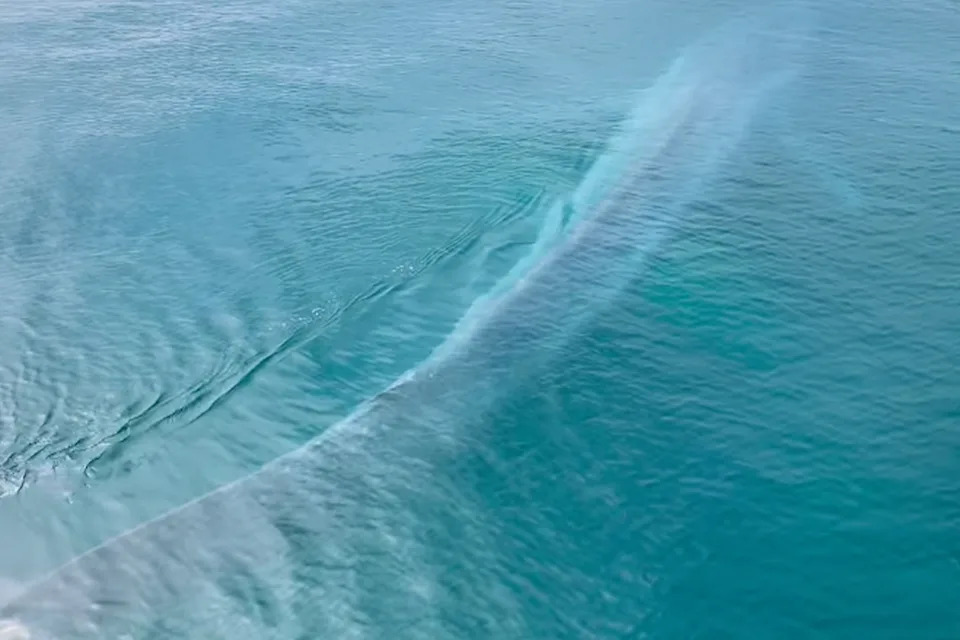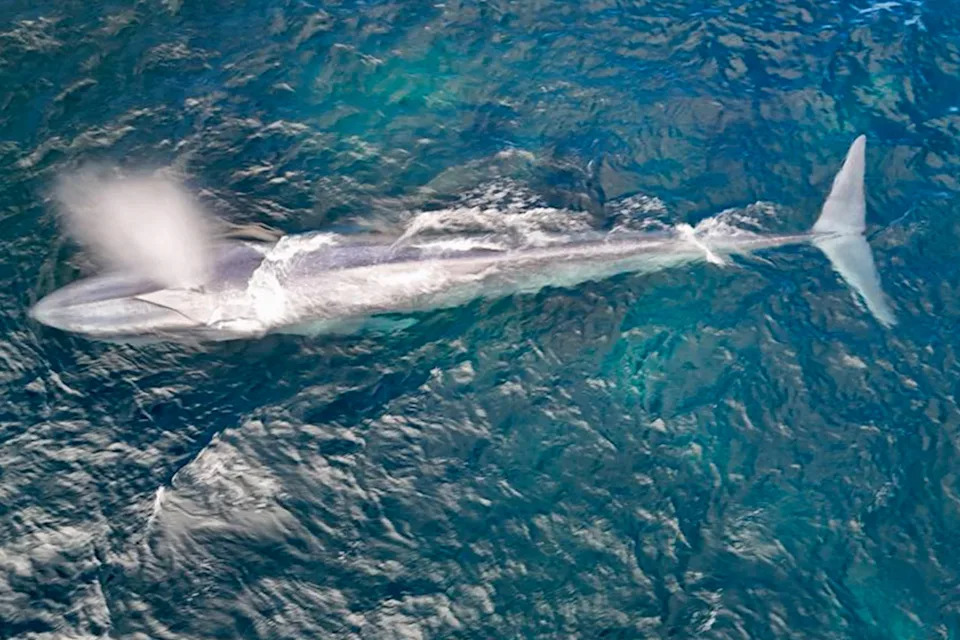A group of friends enjoying a “girls’ getaway” were treated to a “super rare” sight last weekend while strolling along an iconic jetty that stretches almost 2km into the ocean.
Last Saturday, Megan Wood, Sophia Fuimaono, Toneya Scafidi, and Ainsley Tierney were lapping up a long brunch in the popular tourist town of Busselton, about two-and-a-half hours south of their homes in Perth, when a lively debate erupted.
The four mates were admiring a pod of dolphins in Geographe Bay when Ainsley suggested they might be lucky enough to catch a glimpse of a whale on their walk on the Busselton jetty, given they are currently migrating along the coast.
“We basically all rolled our eyes and told her that it’s really unlikely!” Megan told Yahoo News Australia.

The blue pygmy whale swimming slowly past the Busselton Jetty. Source: Megan Wood
However, while wandering along the longest timber jetty in the southern hemisphere, much to their delight and surprise, Ainsley’s prediction came true in a big way when a roughly 24-metre pygmy blue whale suddenly appeared in the water below.
“I didn’t think it was real! I think we were in shock and awe,” Megan said, noting the endangered and elusive species was less than 10 metres away from where they were standing. “He moved so gracefully and was so large. It was really breathtaking.
“I did immediately apologise to Ainsley for suggesting that there was no chance we would see a whale on the jetty. I was happy to be wrong in this instance.”
Viral video footage shows the large whale slowly gliding past the friends in the bright blue water, estimated to be about seven metres deep.
“The Busselton jetty is always quite busy, but at the time when it was right under us, there was only us and a couple who saw it at such close proximity,” Ainsley explained to Yahoo. “During the chance encounter, the couple declared, that’s a blue whale!”
All of the witnesses were “equally excited and in awe of the beauty of the pygmy blue whale”, which the group of mates have since nicknamed Barry the blue, Ainsley added.
In the days following the encounter, the four friends say they have “become self-proclaimed experts in blue whale fun facts”.
“We now know that even researchers who have been studying whales in that area for over 30 years have never seen one from the jetty. It’s super rare!” Megan said.
“We’re all so happy, this entire experience has been incredible, and we’re so glad we could share such uplifting news with millions of people!”
Witnesses thrilled after pygmy blue whale swims close to shore
In May, a group of tourists were treated to an incredible spectacle when a pygmy blue whale suddenly emerged just 15 metres from the shore at Cheynes Beach, a popular stop-off for caravanners on WA’s south coast.
Brian Willey, a keen wildlife photographer, was flying his drone, filming a humpback with his telephoto lens from the required 60 metre distance, when a much bigger whale suddenly “came around the corner”.
“Straight away I could see it was a distinctive blue colour, and the length was much longer than a normal humpback,” he told Yahoo. “I followed it for about five minutes and took about a dozen photos. People were so excited to see such a huge whale so close.”

A group of tourists were treated to an incredible spectacle in May when a pygmy blue whale suddenly emerged from the water near Cheynes Beach. Source: Brian Willey
‘Very little known’ about population sizes of pygmy blue whales
Both pygmy blue whales and Antarctic blue whales, the two subspecies of blue whales found in Australia, can be found in the waters near Albany, Alexia Wellbelove, the Australian Marine Conservation Society’s threatened species campaign manager, told Yahoo.
Every year, endangered pygmy blue whales travel from southern and western Australia where they feed, up to Indonesia to breed — which is why they are also known as the ‘Indo-Australian pygmy blue whale’, Wellbelove said. From September, they venture back down south, passing through Geographe Bay near Busselton.
Incredibly, they can grow up to about 24 metres long and live for 90 years.
Despite their stature, “very little is known about the population size of blue whales”, Wellbelove told Yahoo. “Much more is known about the Antarctic blue whales, which were last estimated to be around 2,000 individuals.”
Sadly, like most whales, they face a “plethora of threats”, including climate change impacting ocean temperatures and upwellings where they feed, and collisions with vessels involved in commercial, recreational or industrial activities.

Earlier this year, researchers were able to place satellite trackers on four pygmy blue whales migrating up the west coast. Source: AIMS
Scientists’ incredible feat after spending week perched in boat
However, efforts to learn more about their populations are underway, with a crew of researchers working tirelessly to attach “state-of-the-art” satellite tags to four pygmy blue whales in June. When the whales surface to breathe, the tags transmit data via satellite to a processing centre and then to the Australian Institute of Marine Science (AIMS) for analysis.
Dr Michele Thums, a research scientist for AIMS, told Yahoo News the tags were attached to the whales on their northern migration “to see where they go, the routes they take and where they spend most of their time.”
“The tags we are using not only record the position of the whales, but also their diving behaviour along their migratory paths, allowing us to learn more about their foraging and feeding behaviour.”
Do you have a story tip? Email: newsroomau@yahoonews.com.
You can also follow us on Facebook, Instagram, TikTok, Twitter and YouTube.


